
Here you can study for the exam. Look up keywords and learn definitions about all kind of subjects.
More subjects
The Ford Focus is a compact car (C-segment in Europe) manufactured by Ford Motor Company since 1998. It was created under Alexander Trotman's Ford 2000 plan, which aimed to globalize model development and sell one compact vehicle worldwide. The original Focus was primarily designed by Ford of Europe's German and British teams. Production of the fourth generation Focus began in 2018 in Germany and China. The decision to name the new car the 'Ford Focus' was made in early 1998, as Ford's senior management had been planning to keep the 'Escort' nameplate for its new generation of small family cars. A last-minute problem arose in July 1998 when a Cologne court, responding to a case brought by the publisher Burda, ordered Ford to avoid the name 'Focus' for the cars in the German market since the name was already taken by one of its magazines (Focus). This eleventh-hour dispute was resolved, however, and the car was launched with the name Focus. (Source: Wikipedia.org, CC BY-SA)
The Ford Freestyle is a crossover utility vehicle that was sold by Ford from 2005 to 2009. Largely marketed as the successor to the Ford Taurus station wagon, the Freestyle was the CUV counterpart of the Ford Five Hundred and Mercury Montego four-door sedans. Sharing the Ford D3 platform with the Five Hundred and Montego, the Freestyle was produced with both front-wheel drive and all-wheel drive configurations and six- or seven-passenger seating. Following the return of the Ford Taurus for the 2008 model year, the Freestyle underwent a mid-cycle revision and was renamed the Ford Taurus X, marketed in the United States and Canada, as well as South Korea and the U.S. territories of Puerto Rico, U.S. Virgin Islands, and Guam. Following the 2009 model year, the Taurus X was withdrawn. From the 2009 model year, the larger Ford Flex has served as the three-row Ford CUV/wagon. (Source: Wikipedia.org, CC BY-SA)
 © Wikimedia.org/IFCAR, CC0
© Wikimedia.org/IFCAR, CC0
The Ford Fusion is a mid-size car that was manufactured and marketed by the Ford Motor Company. From the 2006 through 2020 model years, two generations of the Fusion have been produced in gasoline, gas/electric hybrid, and gas/plug-in electric hybrid variants. The Fusion was manufactured at Ford's Hermosillo Stamping and Assembly plant in Sonora, Mexico, alongside its rebadged variant the Lincoln MKZ, and formerly the Mercury Milan, both of which share its CD3 platform. Production on the first Fusions began on August 1, 2005. The Fusion replaced the Mondeo for the Latin American markets—except in Argentina (where the current European Mondeo is available) and in the United States and Canada (where it superseded the then mid-size Taurus and the compact Contour). The Fusion is positioned between the compact Ford Focus and the full-size Ford Taurus. In the Middle East, this model is sold alongside the Mondeo. Versions sold there are available only with the 2.5-liter engine. Unlike in the United States, Canada, and Latin America, no V6 engine is available in that region. The same is true in South Korea, where only the 2.5-liter engines (including those for the hybrid model) are available as of the 2012 model year. (Source: Wikipedia.org, CC BY-SA)
The Ford GT is a mid-engine two-seater sports car manufactured and marketed by American automobile manufacturer Ford for the 2005 model year in conjunction with the company's 2003 centenary. The second generation Ford GT became available for the 2017 model year. The GT recalls Ford's historically significant GT40, a consecutive four-time winner of the 24 Hours of Le Mans (1966–1969), including a 1-2-3 finish in 1966. The Ford GT began life as a concept car designed in anticipation of the automaker's centennial year and as part of its drive to showcase and revive its 'heritage' names such as Mustang and Thunderbird. At the 2002 North American International Auto Show, Ford unveiled a new GT40 Concept car. Camilo Pardo, the then head of Ford's 'Living Legends' studio, is credited as the chief designer of the GT and worked under the guidance of J Mays. Carroll Shelby, the original designer of the Shelby GT 500, was brought in by Ford to help develop the GT; which included performance testing of the prototype car. While under development, the project was called Petunia. (Source: Wikipedia.org, CC BY-SA)
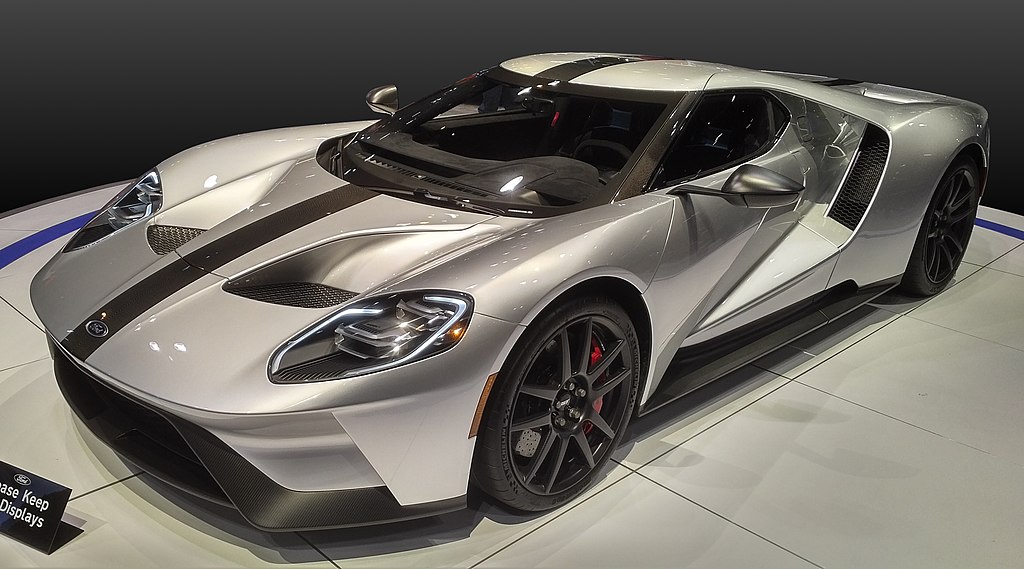 © Wikimedia.org/Ruben de Rijcke, CC BY-SA
© Wikimedia.org/Ruben de Rijcke, CC BY-SA
The North American version of the Ford Granada is a range of sedans that was manufactured and marketed by Ford over two generations (1975–1982). Developed as the original successor for the Ford Maverick, the Granada shares its name with Ford of Europe's flagship sedan. The model line was marketed as a luxury compact vehicle, expanding the segment in the United States. The first generation of the Granada was a compact sedan, between the Maverick and the Torino (and the Fairmont and LTD II that replaced them) in the Ford sedan range. The second generation was a mid-size sedan, marketed alongside the Fairmont and LTD. For the 1983 model year, the Granada underwent a mid-cycle revision, taking on the Ford LTD nameplate; the model line was ultimately replaced by the Ford Taurus after the 1986 model year. In total, over two million examples of the Ford Granada were produced for the U.S. market. The first generation was produced by Mahwah Assembly and Michigan Assembly with the second generation produced by Atlanta Assembly and Chicago Assembly. (Source: Wikipedia.org, CC BY-SA)
The Ford LTD (pronounced ell-TEE-dee) is a range of automobiles manufactured by Ford Motor Company for the 1965 to 1986 model years. Introduced as the highest trim level of the full-size Ford model range, then the Galaxie, the LTD offered options and features that had previously been reserved for more luxurious Lincoln and Mercury models. The largest vehicle produced by Ford in North America for most of its production, the LTD was joined by the intermediate Ford LTD II from 1977 to 1979; the LTD II served as the replacement for the Torino/Gran Torino range. At various times throughout its production, the LTD range included two- and four-door pillared and hardtop sedans, a two-door convertible, and the Country Squire five-door woodgrain station wagon. (Source: Wikipedia.org, CC BY-SA)
The Ford Model A (also colloquially called the A-Model Ford or the A, and A-bone among hot rodders and customizers) was the Ford Motor Company's second market success, replacing the venerable Model T which had been produced for 18 years. It was first produced on October 20, 1927, but not introduced until December 2. This new Model A (a previous model had used the name in 1903–04) was designated a 1928 model and was available in four standard colors. By February 4, 1929, one million Model As had been sold, and by July 24, two million. The range of body styles ran from the Tudor at US$500 (in grey, green, or black) ($7,891 in 2021 dollars ) to the town car with a dual cowl at US$1,200 ($18,937 in 2021 dollars ). In March 1930, Model A sales hit three million, and there were nine body styles available. (Source: Wikipedia.org, CC BY-SA)
The Ford Model T is an automobile that was produced by the Ford Motor Company from October 1, 1908, to May 26, 1927. It is generally regarded as the first affordable automobile, which made car travel available to middle-class Americans. The relatively low price was partly the result of Ford's efficient fabrication, including assembly line production instead of individual handcrafting. It was mainly designed by an American (Childe Harold Wills) and two Hungarian engineers (Joseph A. Galamb, Eugene Farkas). The Model T was colloquially known as the 'Tin Lizzie', 'Leaping Lena' or 'flivver'. (Source: Wikipedia.org, CC BY-SA)
The Ford Mustang is a series of American automobiles manufactured by Ford. In continuous production since 1964, the Mustang is currently the longest-produced Ford car nameplate. Currently in its sixth generation, it is the fifth-best selling Ford car nameplate. The namesake of the 'pony car' automobile segment, the Mustang was developed as a highly styled line of sporty coupes and convertibles derived from existing model lines, initially distinguished by 'long hood, short deck' proportions. Originally predicted to sell 100,000 vehicles yearly, the 1965 Mustang became the most successful vehicle launch since the 1927 Model A. Introduced on April 17, 1964 (16 days after the Plymouth Barracuda), over 400,000 units were sold in its first year; the one-millionth Mustang was sold within two years of its launch. In August 2018, Ford produced the 10-millionth Mustang; matching the first 1965 Mustang, the vehicle was a 2019 Wimbledon White convertible with a V8 engine. (Source: Wikipedia.org, CC BY-SA)
The Ford Pinto is a subcompact car that was manufactured and marketed by Ford Motor Company in North America from 1971 until 1980 model years. The Pinto was the first subcompact vehicle produced by Ford in North America. The Pinto was marketed in three body styles throughout its production: a two-door fastback sedan with a trunk, a three-door hatchback, and a two-door station wagon. Mercury offered rebadged versions of the Pinto as the Mercury Bobcat from 1975 until 1980 (1974–1980 in Canada). Over three million Pintos were produced over its ten-year production run, outproducing the combined totals of its domestic rivals, the Chevrolet Vega and the AMC Gremlin. The Pinto and Mercury Bobcat were produced at Edison Assembly in Edison, New Jersey, St. Thomas Assembly in Southwold, Ontario, and San Jose Assembly in Milpitas, California. (Source: Wikipedia.org, CC BY-SA)
The Ford Puma is a subcompact crossover SUV (B-segment) marketed by Ford since 2019. It is considered an SUV equivalent of the seventh-generation Fiesta. The vehicle is only available for the European and Australasian markets, with sales starting in Europe from 2019 and sales in Australasia from late 2020. In the European market, the Puma is positioned above the EcoSport and below the Kuga (also called Escape outside Europe). An electric version of the Puma will be launched in 2024. (Source: Wikipedia.org, CC BY-SA)
The Ford RS200 is a mid-engined, four-wheel drive sports car that was produced by Ford Motorsport in Boreham, UK, from 1984 to 1986. The road-going RS200 was the basis for Ford's Group B rally car and was designed to comply with FIA homologation regulations, which required 200 parts kits to be produced and at least one road-legal car to be assembled. It was first displayed to the public at the Belfast Motor Show. (Source: Wikipedia.org, CC BY-SA)
The Ford Ranchero is a coupe utility that was produced by Ford between 1957 and 1979. Unlike a standard pickup truck, the Ranchero was adapted from a two-door station wagon platform that integrated the cab and cargo bed into the body. A total of 508,355 units were produced during the model's production run. Over its lifespan it was variously derived from full-sized, compact, and intermediate automobiles sold by Ford for the North American market. During the 1970s, the Ranchero name was used in the South African market for a rebadged Australian Ford Falcon utility. Shipped from Australia in complete knock down (CKD) form, these vehicles were assembled in South Africa at Ford's plant in Port Elizabeth. In Argentina, a utility version of the locally produced Ford Falcon was also called Ranchero. (Source: Wikipedia.org, CC BY-SA)
Ford Ranger is a nameplate that has been used on multiple model lines of pickup trucks sold by Ford worldwide. The nameplate has been used for distinct model lines of vehicles worldwide since 1982 from the compact and mid-size pickup category. The Ford Ranger debuted as a compact pickup mainly sold in North America since 1982 for the 1983 model year, with later introductions in some South American countries. Between 1998 and 2011, the Ranger nameplate is also used for models that was developed by Mazda for sale outside the North American market. In 2011, Ford introduced the first Ranger based on the T6 platform. Considered a mid-size pickup truck, the model was developed in-house by Ford Australia. In the same year, the North American-market Ranger was discontinued, leaving the T6 platform-based Ranger as the sole Ranger model worldwide. (Source: Wikipedia.org, CC BY-SA)
The Ford Sierra is a mid-size car or large family car manufactured and marketed by Ford Europe from 1982-1993, designed by Uwe Bahnsen, Robert Lutz and Patrick le Quément — and noted for its aerodynamic styling producing a drag coefficient of 0.34, a significant improvement over its predecessors. The Sierra debuted at the 1982 British International Motor Show in Birmingham, shortly followed by the 1982 Paris Salon de l'Automobile. Sales began on 15 October 1982, replacing the Ford Taunus TC3 (UK: Ford Cortina Mark V). Its aerodynamic styling and the absence of a saloon/sedan configuration was such that many conservative buyers (including company car drivers) did not prefer its design. A saloon/sedan model debuted in 1987 with the introduction of the facelifted Sierra. (Source: Wikipedia.org, CC BY-SA)
The Ford Taurus is an automobile that was manufactured by the Ford Motor Company in the United States from the 1986 to 2019 model years. Introduced in late 1985 for the 1986 model year, six generations were produced over 34 years; a brief hiatus was undertaken between 2006 and 2007. From the 1986 to 2009 model years, the Taurus was sold alongside its near-twin, the Mercury Sable; four generations of the high-performance Ford Taurus SHO were produced (1989–1999; 2010–2019). The Taurus also served as the basis for the first-ever front-wheel drive Lincoln Continental (1988–2002). The original Taurus was a milestone for Ford and the entire American automotive industry, being the first automobile at Ford designed and manufactured using the statistical process control ideas brought to Ford by W. Edwards Deming, a prominent statistician consulted by Ford to bring a 'culture of quality' to the enterprise. The Taurus had an influential design that brought many new features and innovations to the marketplace. (Source: Wikipedia.org, CC BY-SA)
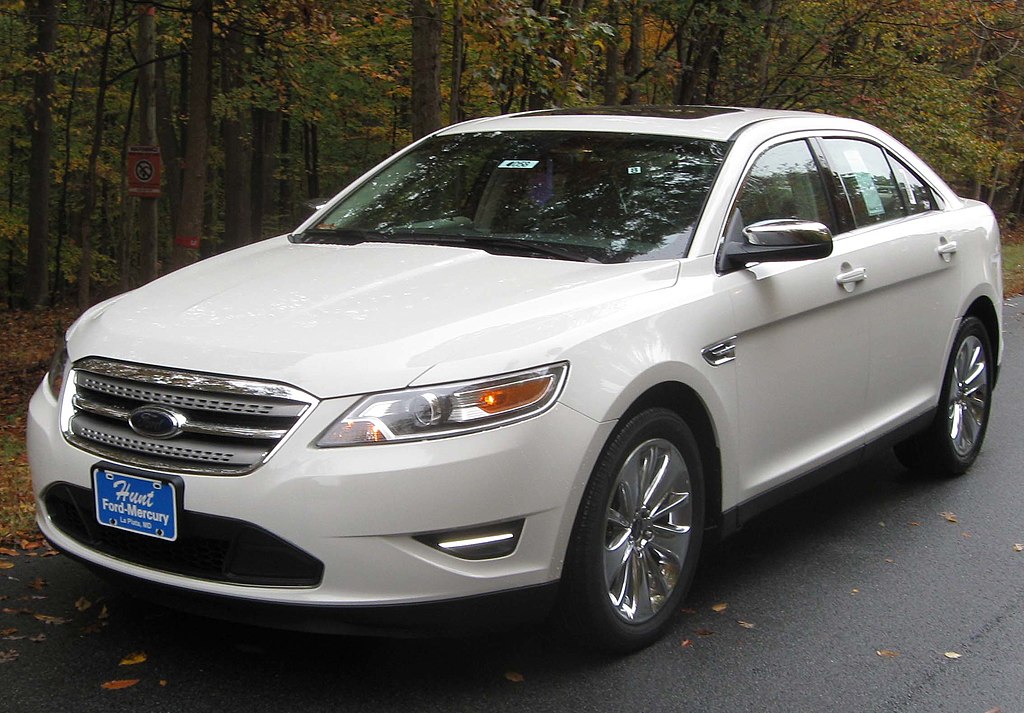 © Wikimedia.org/IFCAR, CC0
© Wikimedia.org/IFCAR, CC0
The Ford Tempo is a compact car that was produced by Ford from the 1984 to 1994 model years. The replacement for the Ford Fairmont, the Tempo was the fourth generation of compact sedans sold by Ford in North America. Along with transitioning to front-wheel drive, the Tempo marked significant downsizing over its predecessor. Mercury marketed the model line under the Mercury Topaz nameplate (no Lincoln version was sold). The model line was produced as a two-door coupe and a four-door sedan through its production. Deriving its chassis underpinnings and powertrain from the Ford Escort, the Tempo/Topaz were the first aerodynamically-styled sedans introduced by Ford, preceded by the 1982 Ford Sierra hatchbacks (Ford of Europe) and the 1983 Ford Thunderbird; they were followed by the 1986 Ford Taurus. (Source: Wikipedia.org, CC BY-SA)
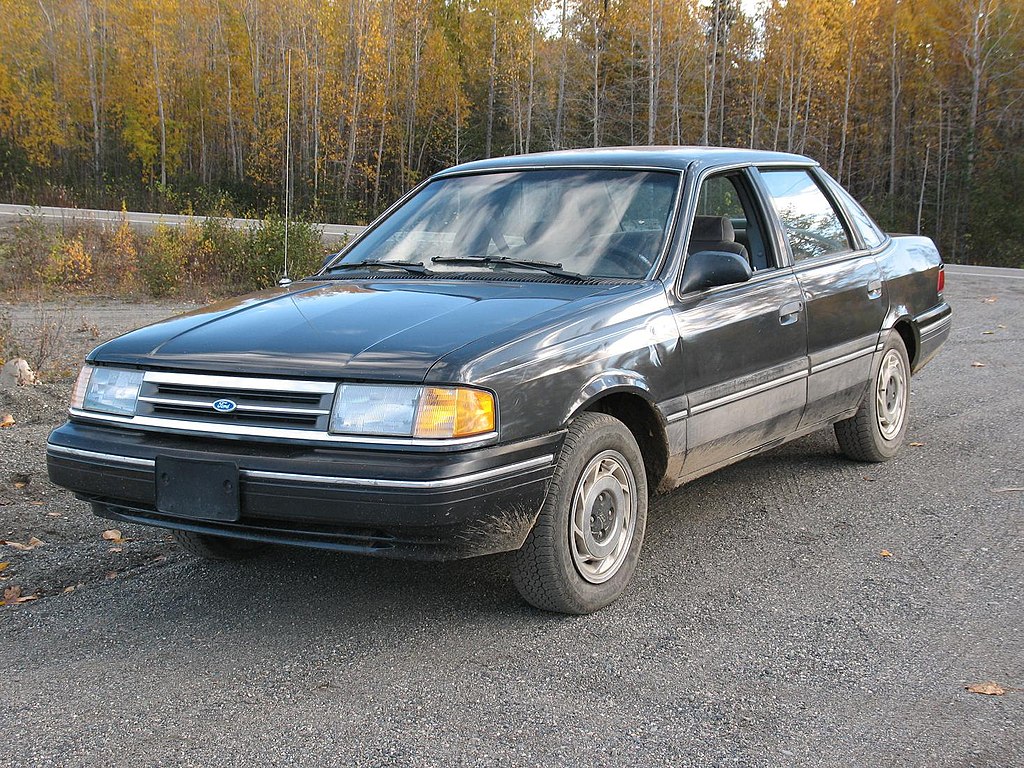 © Wikimedia.org/Explorer4x4, CC0
© Wikimedia.org/Explorer4x4, CC0
The Ford Thunderbird (colloquially called the T-Bird) is a personal luxury car produced by Ford from model years 1955 until 1997 and 2002 until 2005 across 11 distinct generations. Introduced as a two-seat convertible, the Thunderbird was produced in a variety of body configurations. These included a four-seat hardtop coupe, four-seat convertible, five-seat convertible and hardtop, four-door pillared hardtop sedan, six-passenger hardtop coupe, and five-passenger pillared coupe, with the final generation designed again as a two-seat convertible. (Source: Wikipedia.org, CC BY-SA)
The Ford Transit is a family of light commercial vehicles manufactured by the Ford Motor Company since 1965, primarily as a cargo van, but also available in other configurations including a large passenger van (marketed as the Ford Tourneo in some markets since 1995), cutaway van chassis, and a pickup truck. The vehicle is also known as the Ford T-Series (T-150, T-250, T-350), a nomenclature shared with Ford's other light commercial vehicles, the Ford F-Series trucks, and the Ford E-Series chassis. As of 2015, 8 million Transit vans have been sold, making it the third best-selling van of all time and has been produced across four basic platform generations (debuting in 1965, 1986, 2000, and 2013 respectively), with various 'facelift' versions of each. (Source: Wikipedia.org, CC BY-SA)
The Frazer (1946–1951) was the flagship line of upper-medium priced American luxury automobiles built by the Kaiser-Frazer Corporation of Willow Run Ypsilanti, Michigan, and was, with Crosley, the first American car with new envelope body and fresh postwar styling. Named for longtime American automobile executive Joseph W. Frazer who had become president and general manager of Kaiser-Frazer, the Frazer was styled by Howard 'Dutch' Darrin with some input from other K-F stylists. The new Frazer won the Fashion Academy of New York Gold Medal for design achievement. Production began on May 29, 1946 and the Frazer made its public debut June 29, 1946. There was one basic four-door sedan body shell that was shared with the similar but lower-priced (by $200 to $600) Kaiser. The Frazer used the Continental Red Seal 226 CID 'Supersonic' L-head six powerplant which reached 115 hp (86 kW) by the end of Frazer production at the conclusion of the 1951 model year. The luxury line Frazer Manhattan Series F47C was introduced on March 23, 1947 at a $500 premium over the original Frazer Series F-47, which continued on as the Standard. By 1948, Frazer sales totaled about 1.5% of all American cars built. (Source: Wikipedia.org, CC BY-SA)
The GMC Acadia is a crossover SUV manufactured by General Motors for its GMC marque. The first-generation GMC Acadia shared the GM Lambda platform with the Saturn Outlook, the Chevrolet Traverse, and the Buick Enclave. The Acadia went on sale in 2006 as a 2007 model in the United States, Canada and Mexico. The Acadia replaces three of the 7- or 8-seater vehicles on the Pontiac–Buick–GMC dealership network, the midsize GMC Safari van, the GMC Envoy, and the Pontiac Montana SV6 minivan for the domestic market. As of 2009, the Lambda vehicles have replaced the Buick Rainier, Buick Rendezvous, Buick Terraza, and the GMC Envoy XL and then subsequently the GMC Envoy, Chevrolet TrailBlazer and the Isuzu Ascender. A Denali version of the Acadia debuted for 2011. In 2017, the second generation Acadia was repositioned as a mid-size crossover utility vehicle in order to compete within the growing midsize SUV market against the likes of the Ford Explorer, Edge, and Jeep Grand Cherokee. (Source: Wikipedia.org, CC BY-SA)
The GMC Terrain is a crossover SUV by American manufacturer General Motors under its GMC marque. Sharing its platform with the Chevrolet Equinox, the first-generation Terrain was built on GM's Theta platform, while the second-generation model is currently built on the Delta platform. The Terrain is the smallest GMC vehicle slotted below the Acadia. It also indirectly replaced the Pontiac Torrent which was often sold in the same dealerships prior to GM dropping the Pontiac brand. (Source: Wikipedia.org, CC BY-SA)
The Henry J is an American automobile built by the Kaiser-Frazer Corporation and named after its chairman, Henry J. Kaiser. Production of six-cylinder models began in their Willow Run factory in Michigan on July 1950, and four-cylinder production started shortly after Labor Day, 1950. The official public introduction was on September 28, 1950. The car was marketed through 1954. (Source: Wikipedia.org, CC BY-SA)
The Hindustan Ambassador is an automobile manufactured by Hindustan Motors of India from 1957 to 2014, with improvements and changes over its production lifetime. The Ambassador was based on the Morris Oxford series III model, first made by Morris Motors Limited at Cowley, Oxford in the United Kingdom from 1956 to 1959. Despite its British origins, the Ambassador was considered as a definitive Indian car and was fondly called the 'King of Indian roads'. The automobile was manufactured by Hindustan Motors at its Uttarpara plant near Kolkata, West Bengal. On 11 February 2017, Hindustan Motors executed an agreement with PSA Group for the sale of the Ambassador brand, including the trademarks, for a consideration of ₹80 crore (US$10 million). The tie-up entailed two joint-venture agreements between the companies of the two groups. (Source: Wikipedia.org, CC BY-SA)
The Holden Commodore is a full-size car that was sold by Holden from 1978 to 2020. It was manufactured from 1978 to 2017 in Australia and from 1979 to 1990 in New Zealand, with production of the locally manufactured versions in Australia ending on 20 October 2017. Between 2018 and 2020, a rebadged Opel Insignia, built in Germany, was sold in Australia as the Holden Commodore (ZB). All sales of new Commodores ended in 2020, coinciding with the discontinuation of the Holden marque and nameplate entirely. (Source: Wikipedia.org, CC BY-SA)
The Honda Accord (Japanese: ホンダ・アコード, Hepburn: Honda Akōdo, /əˈkɔːrd/), also known as the Honda Inspire (Japanese: ホンダ・インスパイア, Hepburn: Honda Insupaia) in Japan and China for certain generations, is a series of cars manufactured by Honda since 1976, best known for its four-door sedan variant, which has been one of the best-selling cars in the United States since 1989. The Accord nameplate has been applied to a variety of vehicles worldwide, including coupes, station wagons, hatchbacks and a Honda Crosstour crossover. (Source: Wikipedia.org, CC BY-SA)
The Honda Beat is a rear wheel drive, mid-engined two-seat roadster kei car produced from May 1991 until February 1996. The Beat was the last car to be approved by Soichiro Honda before he died in 1991. The total number of cars produced was around 33,600. Most of the production (around two-thirds) occurred in the first year, and then production and sales fell drastically. The design of the car originated from Pininfarina, who then sold the design plan to Honda. The Beat was one of many cars designed to take advantage of Japan's tax-efficient kei car class. (Source: Wikipedia.org, CC BY-SA)
The Honda CR-V (also sold as the Honda Breeze in China since 2019) is a compact crossover SUV manufactured by the Japanese automaker Honda since 1995. The early models were built using the same platform as the Civic. Honda began producing the CR-V in Sayama, Japan, and Swindon, United Kingdom, for worldwide markets, adding North American manufacturing sites in East Liberty, Ohio, United States, in 2007; El Salto, Jalisco, Mexico, in late 2007 (ended in early 2017); Alliston, Ontario, Canada, in 2012; and Greensburg, Indiana, United States, in February 2017. The CR-V is also produced in Wuhan for the Chinese market by Dongfeng Honda, and also marketed as the Breeze in China for the version produced at Guangzhou by Guangqi Honda. Honda states 'CR-V' stands for 'Comfortable Runabout Vehicle,' while the term 'Compact Recreational Vehicle' is used in a British car review article that was republished by Honda. (Source: Wikipedia.org, CC BY-SA)
The Honda Civic (Japanese: ホンダ・シビック, Hepburn: Honda Shibikku) is a series of automobiles manufactured by Honda since 1972. Since 2000, the Civic has been categorized as a compact car, while previously it occupied the subcompact class.[by whom?] As of 2021, the Civic is positioned between the Honda Fit/City and Honda Accord in Honda's global car line-up. The first-generation Civic was introduced in July 1972 as a two-door coupe model, followed by a three-door hatchback that September. With a 1,169 cc transverse engine and front-wheel drive like the British Mini, the car provided good interior space despite overall small dimensions. Initially gaining a reputation for being fuel-efficient, reliable and environmentally friendly, later iterations have become known for performance and sportiness, especially the Civic Type R, Civic VTi, Civic GTi and Civic SiR/Si. (Source: Wikipedia.org, CC BY-SA)
The Honda Element is a compact crossover SUV manufactured by Honda and marketed in North America over a single generation for model years 2003–2011 — and noted for its boxy exterior styling with bi-parting side doors and its boxy, flexible interior layout. Manufactured in East Liberty, Ohio, the Element used a modified second generation CR-V platform with front-wheel or all-wheel drive. By late 2010, shortly before its discontinuation, production had totaled approximately 325,000. (Source: Wikipedia.org, CC BY-SA)
The Honda Fit (Japanese: ホンダ・フィット, Hepburn: Honda Fitto) or Honda Jazz is a small car manufactured and marketed by Honda since 2001 over four generations. It has a five-door hatchback body style and is considered a supermini in the United Kingdom, a subcompact car in the United States, and a light car in Australia. Marketed worldwide and manufactured at ten plants in eight countries, sales reached almost 5 million by mid-2013. Honda uses the 'Jazz' nameplate in Europe, Oceania, the Middle East, Africa, Hong Kong, Macau, Southeast Asia and India; and 'Fit' in Japan, Sri Lanka, China, Taiwan and the Americas. Sharing Honda's global small car platform with the City, Airwave, first-generation Mobilio, Freed and HR-V/Vezel, the Fit is noted for its one-box or monospace design; forward-located fuel tank; configurable seats that fold in several ways to accommodate cargo in varying shapes and sizes— and cargo volume competitive to larger vehicles. (Source: Wikipedia.org, CC BY-SA)
The Honda HR-V is a subcompact crossover SUV (B-segment) manufactured and marketed by Honda over three generations. The first generation HR-V was based on the Honda Logo. It was marketed from 1999 to 2006 in Europe, Japan and select Asia-Pacific markets – and featured three doors (1999–2003) or five doors (1999–2006). The two configurations were internally designated GH2 and GH4 respectively. After a hiatus between 2006 and 2013, Honda reintroduced the nameplate for the second generation HR-V, based on the third-generation Honda Fit. Production began in late 2013 for the Japanese domestic market as the Honda Vezel (Japanese: ホンダ・ヴェゼル, Hepburn: Honda Vezeru), while production started in 2015 for North America, Australia, Brazil and select Asian markets as the HR-V. Apart from Japan, the model is also sold as the Vezel in China. (Source: Wikipedia.org, CC BY-SA)
The Honda Insight (ホンダ・インサイト, Honda Insaito) is a hybrid electric vehicle that is manufactured and marketed by Honda. Its first generation was a two-door, two passenger liftback (1999–2006) and in its second generation was a four-door, five passenger liftback (2009–2014). In its third generation, it became a four-door sedan (2018–2022). It was Honda's first model with Integrated Motor Assist system and the most fuel efficient gasoline-powered car available in the U.S. without plug-in capability — for the length of its production run. Honda introduced the second-generation Insight in Japan in February 2009 and in the United States on March 24, 2009. The Insight was the least expensive hybrid available in the US. In December 2010, Honda introduced a less expensive base model for the 2011 model year. The Insight was launched in April 2009 in the UK as the lowest priced hybrid on the market and became the best selling hybrid for the month. (Source: Wikipedia.org, CC BY-SA)
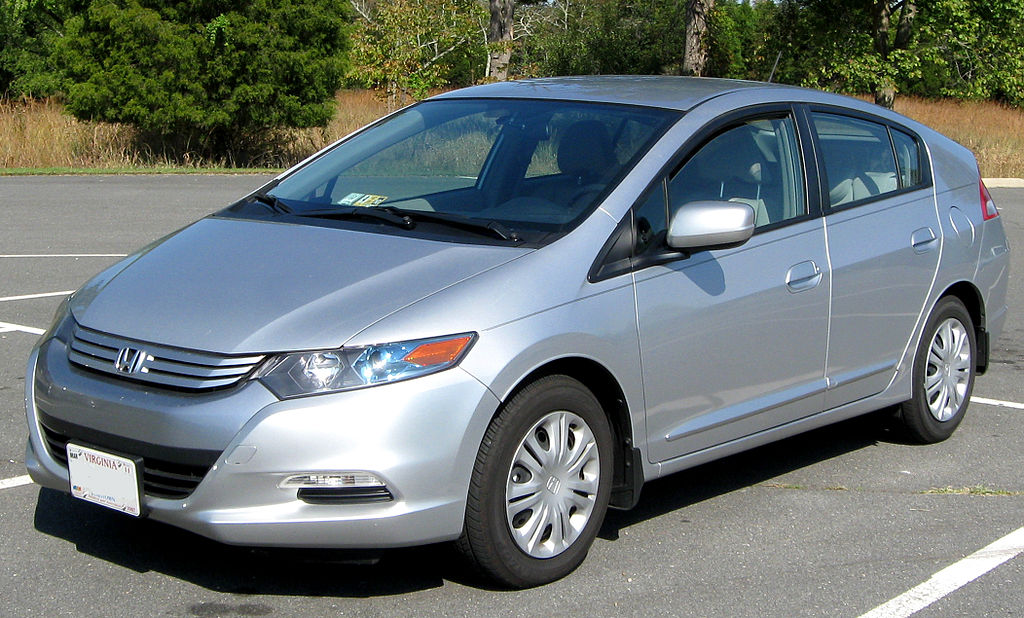 © Wikimedia.org/IFCAR, CC0
© Wikimedia.org/IFCAR, CC0
The Honda Integra (Japanese: ホンダ・インテグラ, Hepburn: Honda Integura), marketed in North America as the Acura Integra, is an automobile produced by the Japanese automobile manufacturer Honda from 1985 until 2006, and then since 2021. It succeeded the Quint as a more luxurious and sport-oriented derivative of the Civic. The Integra was one of the launch models for Acura in the US in 1986 alongside Acura Legend. Throughout its production run, the Integra was highly regarded for its handling and performance. The 1995–2001 Integra Type R is widely regarded as one of the best front-wheel-drive cars of all time. Car and Driver magazine named the Integra to its annual Ten Best list six times: in 1987, 1988, and 1994 through 1997. The GS-R model was called out specifically in 1994 and 1995. It made a return on the Ten Best list as the Acura RSX, in 2002 and 2003. (Source: Wikipedia.org, CC BY-SA)
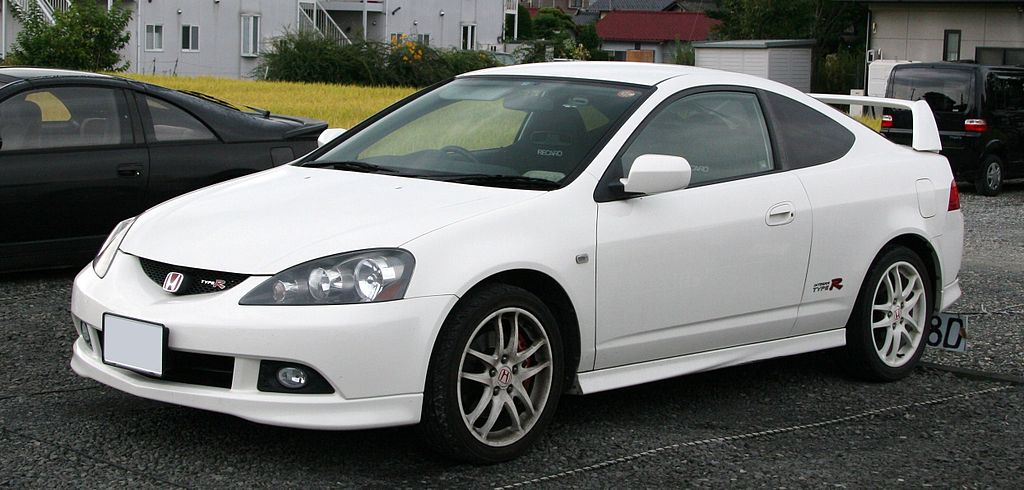 © Wikimedia.org/TTTNIS, CC0
© Wikimedia.org/TTTNIS, CC0
The Honda NSX, marketed in North America as the Acura NSX, is a two-seat, mid-engined coupe sports car manufactured by Honda. The origins of the NSX trace back to 1984, with the HP-X (Honda Pininfarina eXperimental) concept, which was a mid-engine 3.0 L V6 engine rear wheel drive sports car. Honda committed to the project, with the intention of meeting or exceeding the performance of the then V8 engine Ferrari range, while offering reliability and a lower price point. The concept thus evolved and had its name changed to NS-X, which stood for 'New', 'Sportscar' 'eXperimental', although the production model was launched as the NSX. (Source: Wikipedia.org, CC BY-SA)
The Honda Odyssey (Japanese: ホンダ・オデッセイ, Hepburn: Honda Odessei) is a minivan manufactured by Japanese automaker Honda since 1994, marketed in most of the world and currently in its fifth-generation. The Odyssey had originally been conceived and engineered in Japan, in the wake of the country's economic crisis of the 1990s – which in turn imposed severe constraints on the vehicle's size and overall concept, dictating the minivan's manufacture in an existing facility with minimal modification. The result was a smaller minivan, in the compact MPV class, that was well received in the Japanese domestic market but less well received in North America. The first generation Odyssey was marketed in Europe as the Honda Shuttle. (Source: Wikipedia.org, CC BY-SA)
The Honda Passport is a line of sport utility vehicles (SUV) from the Japanese automaker Honda. Originally, it was a badge engineered version of the Isuzu Rodeo, a mid-size SUV sold between 1993 and 2002. It was introduced in 1993 for the 1994 model year as Honda's first entry into the growing SUV market of the 1990s in the United States. The first and second generation Passport was manufactured by Subaru Isuzu Automotive in Lafayette, Indiana. Like various other Honda models, it re-used a name from their motorcycle division, the Honda C75 Passport. The other two name candidates were Elsinore and Odyssey, the latter would be re-used a year later on a minivan. (Source: Wikipedia.org, CC BY-SA)
The Honda Pilot is a mid-size crossover SUV with three-row seating manufactured by Honda since 2002. Primarily aimed at the North American market, the Pilot is the largest SUV produced by Honda. Pilots are currently manufactured in Lincoln, Alabama, and the Pilot was produced in Alliston, Ontario until April 2007. The first generation Pilot was released in April 2002 as a 2003 model. The Pilot shares its platform with the Acura MDX, as well as the North American market Odyssey minivan. The Pilot's unibody construction and independent suspension are designed to provide handling similar to that of a car, and it has integrated perimeter frame rails to permit towing and light off-road use. (Source: Wikipedia.org, CC BY-SA)
The Honda Prelude is a car produced by Japanese manufacturer Honda over five generations from 1978 to 2001. It is a two-door coupé and was loosely derived from the Honda Accord. The Prelude was used by Honda to introduce the Japanese Honda retail sales chain Honda Verno, with the international release of the model following shortly after. Production of the Prelude concluded in 2001 upon the introduction of the fourth-generation Integra. The Prelude name was originally trademarked by Toyota, but was amicably given to Honda for use. The Prelude complied with the series of music-themed vehicle names which Honda used at the time, along with the Accord, Quintet, Concerto, Jazz, and Ballade. (Source: Wikipedia.org, CC BY-SA)
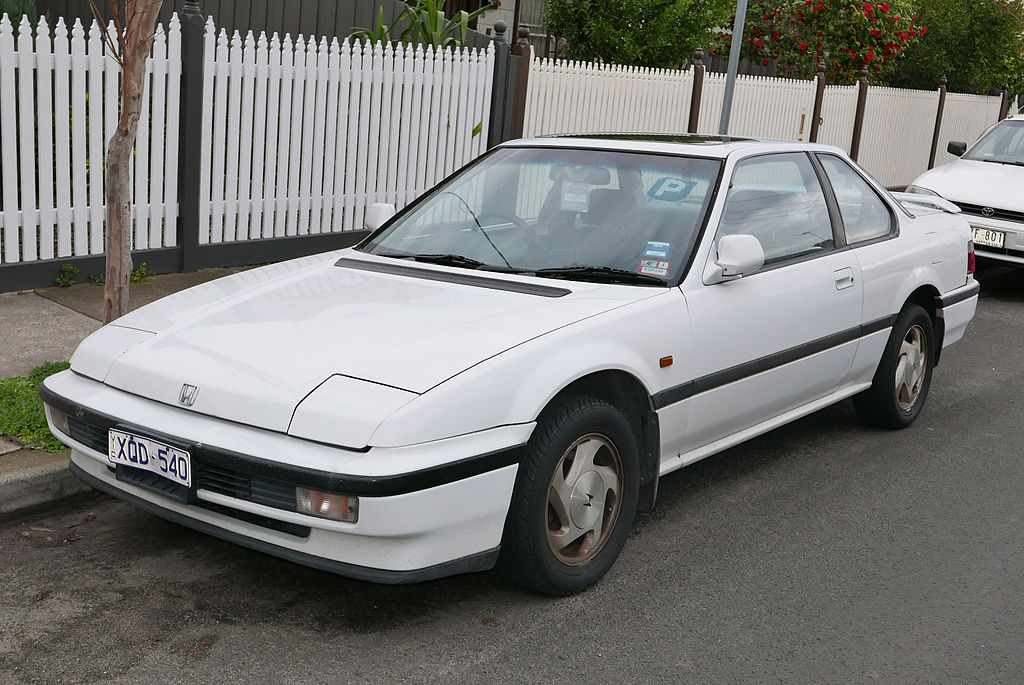 © Wikimedia.org/OSX, CC0
© Wikimedia.org/OSX, CC0
The Honda Ridgeline is a midsize pickup truck manufactured by Honda. The Ridgeline is the only pickup truck currently produced by Honda. The Ridgeline is built using a unibody frame, a transverse-mounted engine, and is only offered in a crew–cab short-box configuration with one powertrain. The first generation Ridgeline went on sale in March 2005 as a 2006 model year vehicle. According to the author of The Car Design Yearbook, the Ridgeline was 'Honda's first foray into the true heartland of the American automotive way of life—the pickup truck.' It was designed and engineered by an engineering team from Honda R&D Americas, led by Gary Flint. According to the author of Driving Honda, the automaker wanted to target buyers who were looking to transition out of sedans, minivans, and sport utility vehicles (SUV) into pickups. (Source: Wikipedia.org, CC BY-SA)

Time for recess! Post a comment, ask a question or write a review. Feel free to let us know what you think!
look at the sign on the road to avoid accidents and horrible driving conditions
I received a 300$ ticket because I passed a police control of other cars/drivers on the right lane of a highway (the control was on the hard shoulder of the highway). Is it really true, that you have to change the lane in such cases? Thanks!
I am an American living in Italy. The Italian Drivers License theory test is the hardest test I have ever studied for and I am in my 70s have multiple degrees, multiple professional certifications. Have to take the Italian Drivers Theory test in Italian. No english. So many rules. More signs in small medieval Italian town I live in then in major US cities I have lived in. No Italian license no driving. No buying or renting a car. Test here was good, clean. Lots of tricky questions on many practice and real official tests. Thanks
Most problems are a result of higher than safe driving speeds. Please just slow down and be patient.
Question 121: Poor translation: Vehicles with polluted fluids prohibited Should be translated as: Vehicles with dangerous liquids prohibited
Question 83: Poor translation: Vehicles with polluted fluids prohibited Should be translated as: Vehicles with dangerous liquids prohibited
Want even more practice? Visit similar websites offering realistic practice driving knowledge tests. Visit us to see what sets our tests apart! https://dkttest.com/capital-territory/
Cool tool! And fun to check whether I remember the rules :) Two things I noticed: Warning for a crossroad side roads on the left and right. While technically that might be the correct translation, this sign tells you, that you are on the main road and have the right of way for the next crossroad and only the next crossroad. Usually (if no sign specifies otherwise) you have to give way to drivers coming from the right at every intersection, which can get a bit annoying in communal areas, so seeing this sign feels less like a warning and more like relief :). A Fahrradstraße is not a lane for cyclists but a street for cyclists, meaning the (whole!) street is intended predominantly for cyclists, who are then allowed to ride next to each other. Cars are allowed to drive there (unless another sign prohibits such), but have to adjust their speed to the cyclists. I believe they are not allowed to pass at all, even if the oncoming lane is empty.
More community